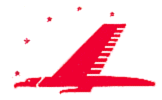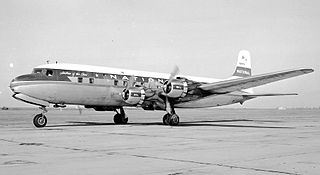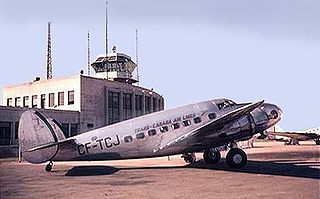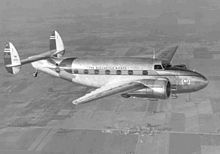
St. Pete–Clearwater International Airport is a public/military airport in Pinellas County, Florida serving the Tampa Bay Area. It is right on the northeast municipal boundary of Pinellas Park, 9 miles (14 km) north of downtown St. Petersburg, 7 miles (11 km) southeast of Clearwater, and 17 miles (27 km) southwest of Tampa.

Capital Airlines was an airline serving the eastern, southern, southeastern, and midwestern United States. Capital's headquarters were located at Washington National Airport across the Potomac river from Washington, D.C. where crew training and aircraft overhauls were also accomplished. In the 1950s Capital was the fifth largest United States domestic carrier by passenger count after the Big Four air carriers.

National Airlines Flight 2511 was a United States domestic passenger flight from New York City to Miami, Florida. On January 6, 1960, the Douglas DC-6 serving the flight exploded in midair. The National Airlines aircraft was carrying 5 crew members and 29 passengers, all of whom perished. The Civil Aeronautics Board investigation concluded that the plane was brought down by a bomb made of dynamite. No criminal charges were ever filed, nor was the blame for the bombing ever determined, though a suicide bombing is suspected. The investigation remains open today.

Eastern Air Lines Flight 663 was a domestic passenger flight from Boston, Massachusetts, to Atlanta, Georgia, with scheduled stopovers at John F. Kennedy International Airport, New York; Richmond, Virginia; Charlotte, North Carolina; and Greenville, South Carolina. On the night of February 8, 1965, the aircraft serving the flight, a Douglas DC-7, crashed near Jones Beach State Park, New York, just after taking off from JFK Airport. All 79 passengers and five crew aboard perished.

American Airlines Flight 383 was a nonstop flight from New York City to Cincinnati on November 8, 1965. The aircraft was a Boeing 727, with 57 passengers, and 5 crew on board. The aircraft crashed on final approach to the Cincinnati/Northern Kentucky International Airport located in Hebron, Kentucky, United States. Only three passengers and one flight attendant survived the crash.

Lakeland Linder International Airport is a public airport five miles southwest of Lakeland, in Polk County, Florida. The Federal Aviation Administration (FAA) National Plan of Integrated Airport Systems for 2017–2021 categorized it as a national reliever facility for Tampa International Airport. The airport has a Class 1 Federal Aviation Regulation (FAR) Part 139 operating certificate allowing passenger airline flights.

Trans World Airlines (TWA) Flight 159 was a regularly scheduled passenger flight from New York City to Los Angeles, California, with a stopover in Cincinnati/Northern Kentucky International Airport, Kentucky, that crashed after an aborted takeoff from Cincinnati on 6 November 1967. The Boeing 707 attempted to abort takeoff when the copilot became concerned that the aircraft had collided with a disabled DC-9 on the runway. The aircraft overran the runway, struck an embankment and caught fire. One passenger died as a result of the accident.

Eastern Air Lines Flight 537, registration N88727, was a Douglas DC-4 aircraft en route from Boston, Massachusetts to Washington, D.C. via intermediate points on November 1, 1949. NX-26927 was a Lockheed P-38 Lightning being test-flown for acceptance by the Government of Bolivia by Erick Rios Bridoux of the Bolivian Air Force. The two aircraft collided in mid-air at an altitude of 300 feet about half a mile southwest of the threshold of Runway 3 at Washington National Airport, killing all 55 aboard the DC-4 and seriously injuring the pilot of the P-38. At the time it was the deadliest airliner incident in United States history.

Northwest Airlines Flight 1, registration NC17389, was a Lockheed Model 14 Super Electra aircraft which crashed in eastern Montana on Friday, January 13, 1939, approximately a half-mile (0.8 km) southwest of the Miles City Airport. All four on board were killed in the accident.
National Airlines was a United States airline that operated from 1934 to 1980. For most of its existence the company was headquartered at Miami International Airport, Florida. At its height, National Airlines had a network of "Coast-to-Coast-to-Coast" flights, linking Florida and the Gulf Coast such as New Orleans and Houston with cities along the East Coast as far north as Boston as well as with large cities on the West Coast including Los Angeles and San Francisco. From 1970 to 1978, National, Braniff International Airways, Pan American World Airways and Trans World Airlines (TWA) were the only U.S. airlines that operated scheduled passenger flights to Europe.

The Grand Canyon mid-air collision occurred in the western United States on Saturday, June 30, 1956, when a United Airlines Douglas DC-7 struck a Trans World Airlines Lockheed L-1049 Super Constellation over Grand Canyon National Park, Arizona. All 128 on board both flights perished, making it the first commercial airline incident to exceed one hundred fatalities. The flights had departed Los Angeles International Airport minutes apart for Chicago and Kansas City, respectively.

American Airlines Flight 63 was an American Airlines DC-3 nicknamed the Flagship Missouri that crashed on October 15, 1943, near Centerville, Tennessee, after ice formed on its wings and propeller. All eight passengers and three crewmembers perished. This was the second fatal crash of an aircraft designated Flight 63, occurring two-and-a-half months after the crash of the Flagship Missouri’s sister ship, the Flagship Ohio.

TAME Flight 120 was a Boeing 727-134 airliner, registration HC-BLF, named El Oro, operating as a scheduled international passenger flight between Quito, Ecuador and Cali, Colombia, with a scheduled stopover at the Ecuadorian border town of Tulcán. The aircraft crashed while on approach to Tulcán's Teniente Coronel Luis A. Mantilla International Airport on January 28, 2002. The pilot flew the approach incorrectly in reportedly foggy conditions, and the aircraft crashed into the side of the Cumbal Volcano, located near Ipiales, Colombia, at 10:23 in the morning. All passengers and crew were killed in the crash.

Northwest Airlines Flight 421 was a domestic scheduled passenger flight from Chicago, Illinois to Minneapolis, Minnesota that crashed on 29 August 1948. The Martin 2-0-2 aircraft, operated by Northwest Airlines, suffered structural failure in its left wing and crashed approximately 4.1 miles (6.6 km) northwest of Winona, Minnesota, about 95 miles (153 km) southeast of Minneapolis. A Civil Aeronautics Board investigation determined that the crash was caused by fatigue cracks in the wings of the aircraft, and recommended lower speeds and frequent inspections of all Martin 2-0-2 aircraft. All 33 passengers and four crewmembers on board were killed. The crash was the first loss of a Martin 2-0-2, and remains the worst accident involving a Martin 2-0-2.

American Airlines Flight 28 was a scheduled domestic passenger flight that crashed on October 23, 1942, in Chino Canyon, near Palm Springs, California, after being struck by a United States Army Air Forces B-34 'Lexington' bomber. The B-34 suffered only minor damage, and landed safely at the Army Airport of the Sixth Ferrying Command, Palm Springs.

On 22 December 2009, an American Airlines Boeing 737-800, operating American Airlines Flight 331 and carrying 148 passengers and six crew, overran runway 12 on landing at Kingston in poor weather. The plane continued on the ground outside the airport perimeter and broke apart on the beach, causing injuries.

On 10 March 1949 a Lockheed Lodestar aircraft became airborne at Coolangatta, Queensland, Australia for a flight to Brisbane. Before reaching a height of 300 feet (90 m) it suddenly pitched nose-up, stalled and crashed onto its belly beyond the end of the airstrip.

Pan Am Flight 923 was a Douglas DC-4 operating from Seattle, Washington to Juneau, Alaska, which crashed into Tamgas Mountain on Annette Island, Alaska, on October 26, 1947. All 18 passengers and crew on board were killed.
















